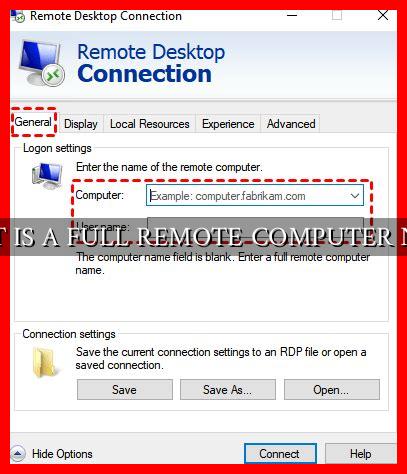-
Table of Contents
Understanding Full Remote Computer Name
Remote computer names play a crucial role in networking and remote access. When it comes to accessing a computer remotely, understanding what a full remote computer name is essential. In this article, we will delve into the concept of a full remote computer name, its significance, and how it is used in various networking scenarios.
What is a Full Remote Computer Name?
A full remote computer name, also known as a Fully Qualified Domain Name (FQDN), is a unique identifier that specifies the exact location of a computer on a network. It consists of the hostname of the computer followed by the domain name. For example, a full remote computer name could be “computer1.example.com,” where “computer1” is the hostname and “example.com” is the domain name.
Significance of Full Remote Computer Name
Having a full remote computer name is crucial for various networking tasks, such as remote access, file sharing, and network administration.
. It allows users to easily identify and connect to specific computers on a network, regardless of their physical location. Additionally, a full remote computer name helps in resolving domain name system (DNS) queries, ensuring seamless communication between devices.
How is a Full Remote Computer Name Used?
Full remote computer names are used in a variety of networking scenarios, including:
- Remote Desktop Connection: When connecting to a remote computer using Remote Desktop Protocol (RDP), users need to enter the full remote computer name to establish a connection.
- File Sharing: In a network environment, users can access shared files and folders on remote computers by specifying the full remote computer name in the file path.
- Network Administration: IT administrators use full remote computer names to manage and monitor devices on a network, making it easier to troubleshoot issues and perform maintenance tasks.
Example of Full Remote Computer Name
Let’s consider an example to illustrate the concept of a full remote computer name. In a corporate network, a user wants to access a file stored on a server named “fileserver” in the domain “company.com.” The full remote computer name for the server would be “fileserver.company.com.” By entering this full remote computer name, the user can access the file seamlessly.
Conclusion
In conclusion, a full remote computer name is a critical component of networking that facilitates remote access, file sharing, and network administration. By understanding the concept of a full remote computer name and its significance, users can effectively navigate and utilize network resources. Whether you are a network administrator or an end user, knowing how to use full remote computer names can enhance your networking experience and streamline communication across devices.




